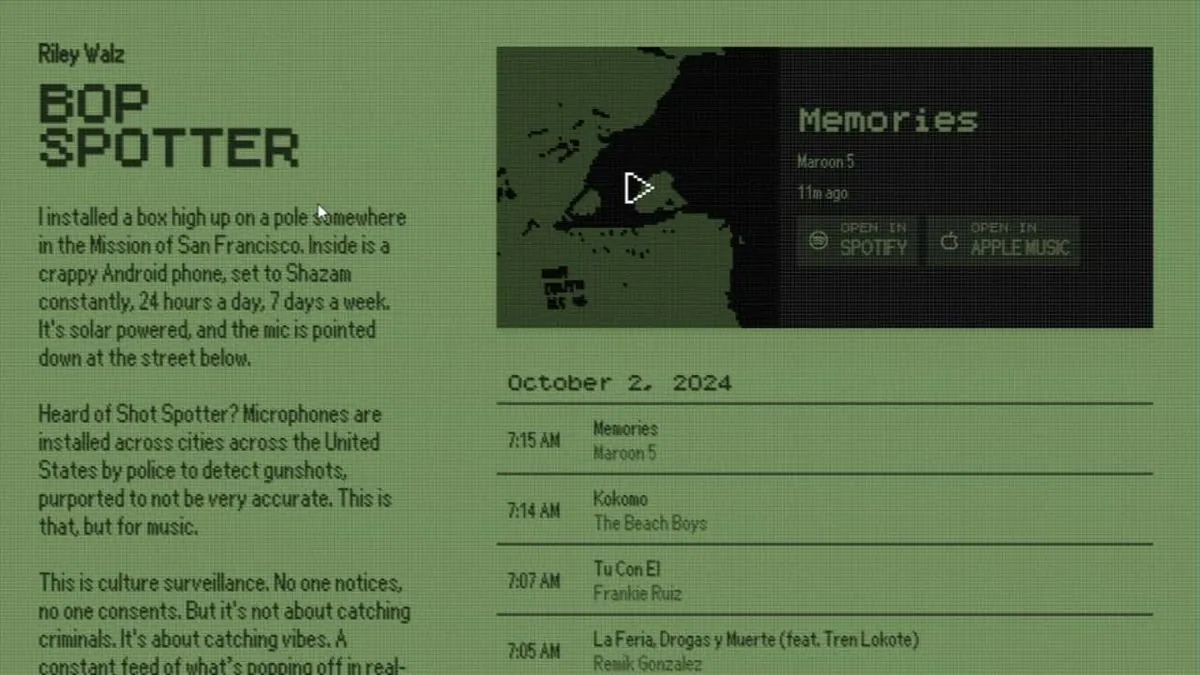In a unique blend of technology and urban exploration, Riley Walz, a 22-year-old programmer, has embarked on an intriguing project in San Francisco. Dubbed "Bop Spotter," this innovative experiment aims to capture the city's musical pulse using a cleverly designed device.
Walz's creation consists of a solar-powered Android phone running the Shazam app, a microphone, and a small solar panel, all mounted on a pole in a bustling area of the Mission District. This setup has been diligently recording and identifying songs played in public spaces for a week, amassing a catalog of approximately 900 tunes.
The project's website allows visitors to listen to snippets of identified songs, interspersed with ambient street sounds. This auditory tapestry provides a fascinating glimpse into the city's musical preferences and daily rhythms. Interestingly, the Mission District, where Bop Spotter is located, has been a cultural hub for artists and musicians since the 1960s, making it an ideal location for such an experiment.
Walz's inspiration for Bop Spotter stems from his habit of using Shazam to identify songs in various settings. He explains, "When I hear a song in person and listen to it later, it reminds me of what I was feeling at that moment." This personal connection to music identification technology, which has been evolving since the launch of the first mobile phone with music recognition capability in 2002, adds a human touch to the project.
The technical aspects of Bop Spotter are equally intriguing. The device records 10-minute audio segments, uploads them to a server using public WiFi, and then processes the audio through Shazam's API. This process showcases the power of modern smartphones, which typically have a battery life of about 10 hours of active use, extended here through solar power.
Public reaction to Bop Spotter has been overwhelmingly positive, with the website receiving over 300,000 visits. Walz has received requests for the source code and instructions to replicate the project in other cities, highlighting the growing interest in creative tech applications.
While some have raised privacy concerns, Walz maintains that the device only captures publicly audible music in an already busy area. This stance echoes ongoing discussions about urban surveillance and public space monitoring, reminiscent of systems like ShotSpotter, a gunshot detection technology founded in 1996.
Bop Spotter's findings offer intriguing insights into the city's musical tastes. From Celine Dion's "All By Myself" playing in the middle of the day to a string of Temptations songs on a Wednesday afternoon, the project paints a vivid picture of San Francisco's diverse soundscape. It even captured instances of "rickrolling," a internet meme that became popular in 2007, showing how online culture permeates real-world spaces.
For Walz, Bop Spotter is more than just a clever use of technology; it's a continuation of his creative tech experiments. His previous projects, including creating a fictional in-demand steakhouse, demonstrate his passion for using technology in unconventional ways.
"Technology is so much fun. You can make something from nothing. I hope that this is inspiring the next group of high-schoolers."
As Bop Spotter continues to capture the musical heartbeat of San Francisco, it serves as a testament to the creative potential of technology and the enduring human fascination with music. From the first music identification service, Musicbrainz, launched in 2000, to today's sophisticated apps like Shazam, our desire to connect with and understand the music around us remains strong. Walz's project not only satisfies this curiosity but also encourages others to explore the intersection of technology, music, and urban life.
